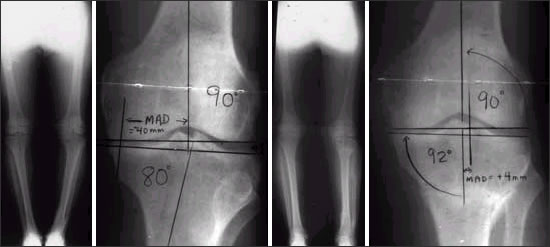Arthritis
The usual treatment for arthritis is joint replacement or fusion of a joint. Our approach, whenever possible, is to try to save the joint while eliminating deformity and pain. This involves specialized osteotomies (bone cuts) to realign the joint and/or joint distraction (pulling apart of the joint). We use these techniques in the hip, knee, and ankle joints. Joint preservation should always be considered before one commits to joint replacement or fusion, especially in patients younger than 60 years. After joint replacement or fusion, one no longer has the option of trying to preserve the joint. However, if joint preservation is not successful, replacement and fusion remain viable options.

Radiographs of a 40-year-old man with pain and arthritis of the knee. The leg had a mild bowing deformity, which caused uneven wear of the inner aspect of the knee joint. To prevent the arthritis from progressing, we realigned the leg by means of an osteotomy (bone cut). This straightened out the deformity and stopped further deterioration of the knee joint. The patient’s pain was completely relieved. He remains active and painless 12 years after his surgery. The osteotomy correction was performed using an Ilizarov external fixator.
This 55-year-old man presented to us with severe arthritis of the lateral (outer) side of the knee joint due to marked knock-knee deformity. Because of the knock-knee deformity, he had overloaded the outside of the knee while the inside of the knee was relatively unloaded. He was sent to us for realignment before undergoing total knee replacement. We performed a procedure developed at our Center called fixator-assisted nailing. This method allows for extremely accurate deformity correction using an external fixator at surgery and then internal fixation with an internal rod. The external fixator is removed during surgery once the rod is in place. The purpose of the external fixator is to adjust and hold the correction after the osteotomy is performed. A radiograph is obtained in the operating room to confirm whether the planned amount of correction has been achieved. We aim to achieve an accuracy of ± 1 degree. If the initial correction is not exact, we can adjust the fixator until the desired correction is achieved. At that point, we insert the internal rod and remove the external fixator. This method offers the convenience and comfort of an internal device with no external fixator or pins with the accuracy of correction that is possible only with an external fixation device. The radiographs show the knee before and after correction. With realignment, the patient remains completely asymptomatic 10 years after surgery. Thus far, he has not needed a knee replacement. This result is especially remarkable considering that the patient weighs 300 lbs. One can also see that he underwent realignment surgery for his left knee bowing deformity and arthritis of the inside of the knee, similar to the above cases. We also treated the left side using the fixator-assisted nailing method.
This 59-year-old woman presented to us in a wheelchair unable to walk because of left knee pain. We treated her using the fixator-assisted nailing method described in the previous case. She had a very complicated deformity of the femur that required three levels of osteotomy and a deformity of the tibia that required one level of osteotomy. We corrected all levels of deformity. The patient recovered quickly from this surgery and, with appropriate aggressive physical therapy, was able to return to a normal, active, pain-free life. At 8 years after surgery, the severe osteoporosis that she had as a result of being in a wheelchair for so long went away because of walking on the limb. She has not required knee replacement to date.
